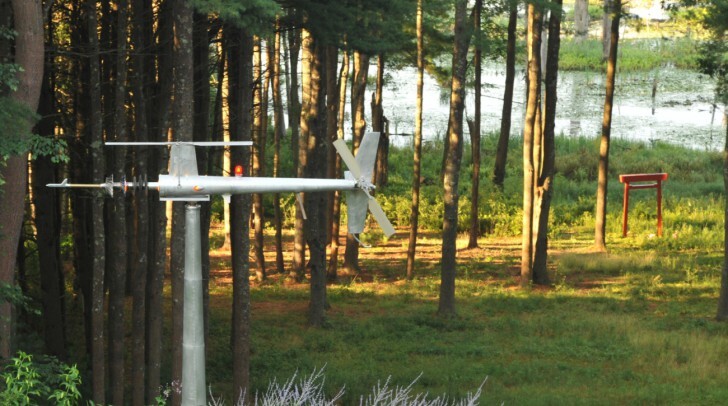First published in Flight Levels Online, Summer 2013 issue

John Wood of Concord, Massachusetts, is a former partner in a Commander 1000, and although he now flies a jet he says the Commander “remains one of my favorite aircraft.” Wood still reads Flight Levels, especially Helmuth Eggeling’s “Flying the Engine” columns, even though “we have no props to spin after shutdown” in the jet.

Wood is a creative tinkerer, and one of his recent projects –– a weathervane –– involved the use of run-out components from a Honeywell TPE331 engine and Robinson helicopters. Here, in his own words, is Wood’s description of the “FrankenCopter.”
Lightning flashes over the mad scientist’s mountain-top laboratory. The sound of a rivet gun echoes through the valley. A strange object is taking shape… part helicopter, part aircraft engine…”It’s alive!” FrankenCopter is a piece of outdoor sculpture –– a weathervane, fashioned from run-out aircraft components.
Leading the way at the nose is a World War II vintage pitot/static tube, followed by the rotating group of a Honeywell Garrett TPE-331 engine, followed by the tail section of a Robinson R-22 helicopter, with a main rotor made of Robinson R-44 tail rotor blades.
The eighty-pound weathervane is precisely balanced, and rotates on a Subaru Outback front wheel bearing assembly on top of a ten-foot pylon made from a Robinson R-22 tail boom.

The aircraft components were stripped to bare metal so there is no paint to maintain, and they will weather (read rust, for steel) naturally.
The engine turbine wheels had reached end of life at overhaul. The two compressor stages became available when a Canadian crew discovered they should have removed the red plastic inlet plug before starting.
The builder took certain liberties with aircraft design; the main-rotor control system is quite unconventional. Dragon eyes and the flames of hot-rod flourishes are incorporated elsewhere.

The weathervane incorporates numerous LEDs to illuminate navigation lights, the anti-collision beacon and accent lights. They are powered by a twelve-volt electrical system supplied through a wind turbine slip ring in the bearing assembly.
The sculpture is solar powered. A sixty-watt solar panel charges two lead-acid gel cell batteries through a charge controller circuit board. The LEDs are turned on or off using a lighted button on the pylon, visible above, or a wireless remote.
The pylon is mounted on a 360-pound cast concrete footing using leveling bolts. An access door cut into the pylon allows access to batteries and electronics.
Installation was straight forward… with some help.
Four-year old grandson Paddy conducts a final inspection. With a large vertical stabilizer, the weathervane turns smoothly to face into only a couple of knots of wind. We’ll see how it handles the New England snow load. Like any aircraft, FrankenCopter, has a squawk list. Air traffic control reports that the transponder is inoperative.
The weathervane overlooks a beaver pond and Japanese torii gate in Concord, Massachusetts. Visitors are welcome.
